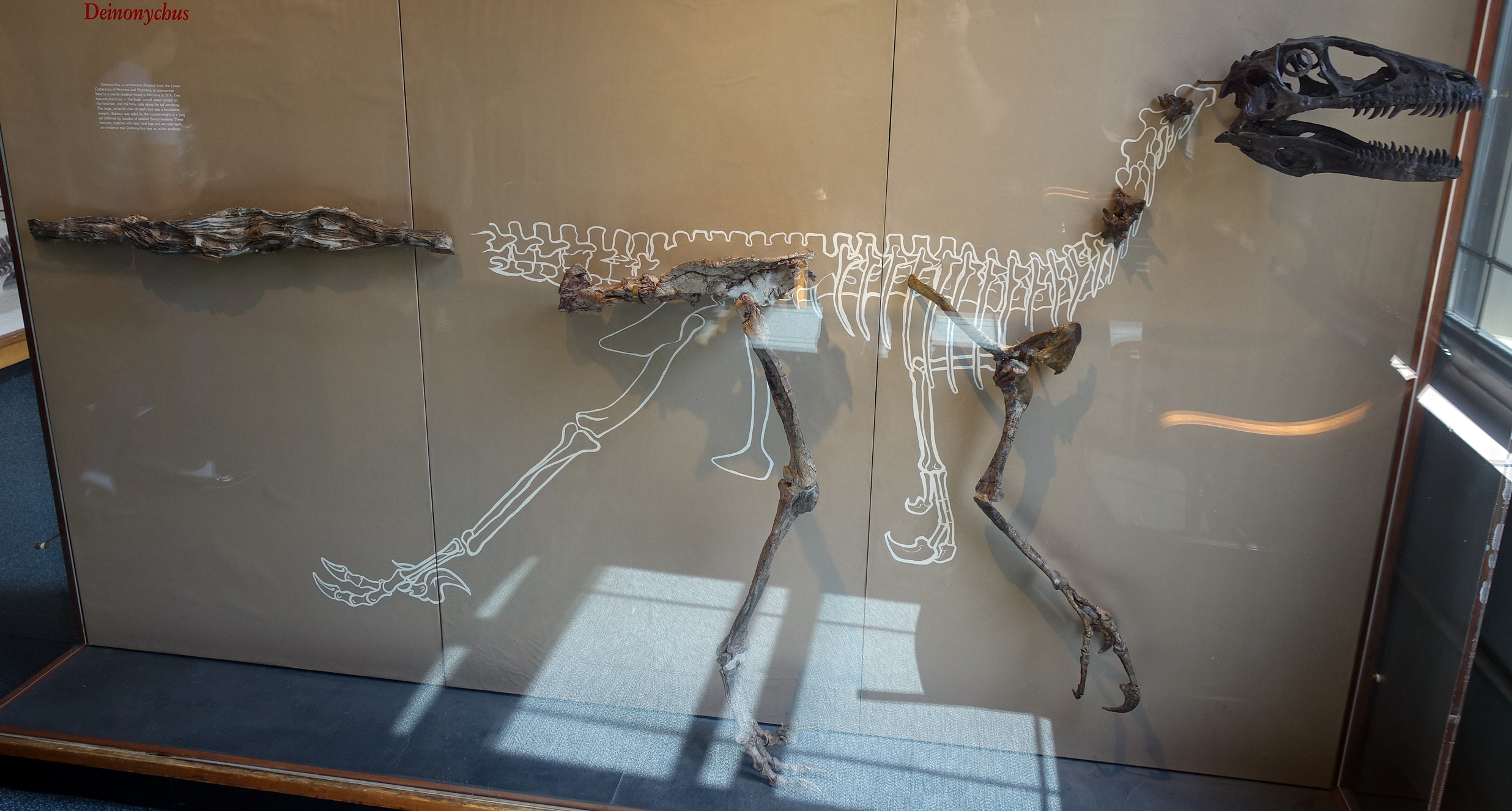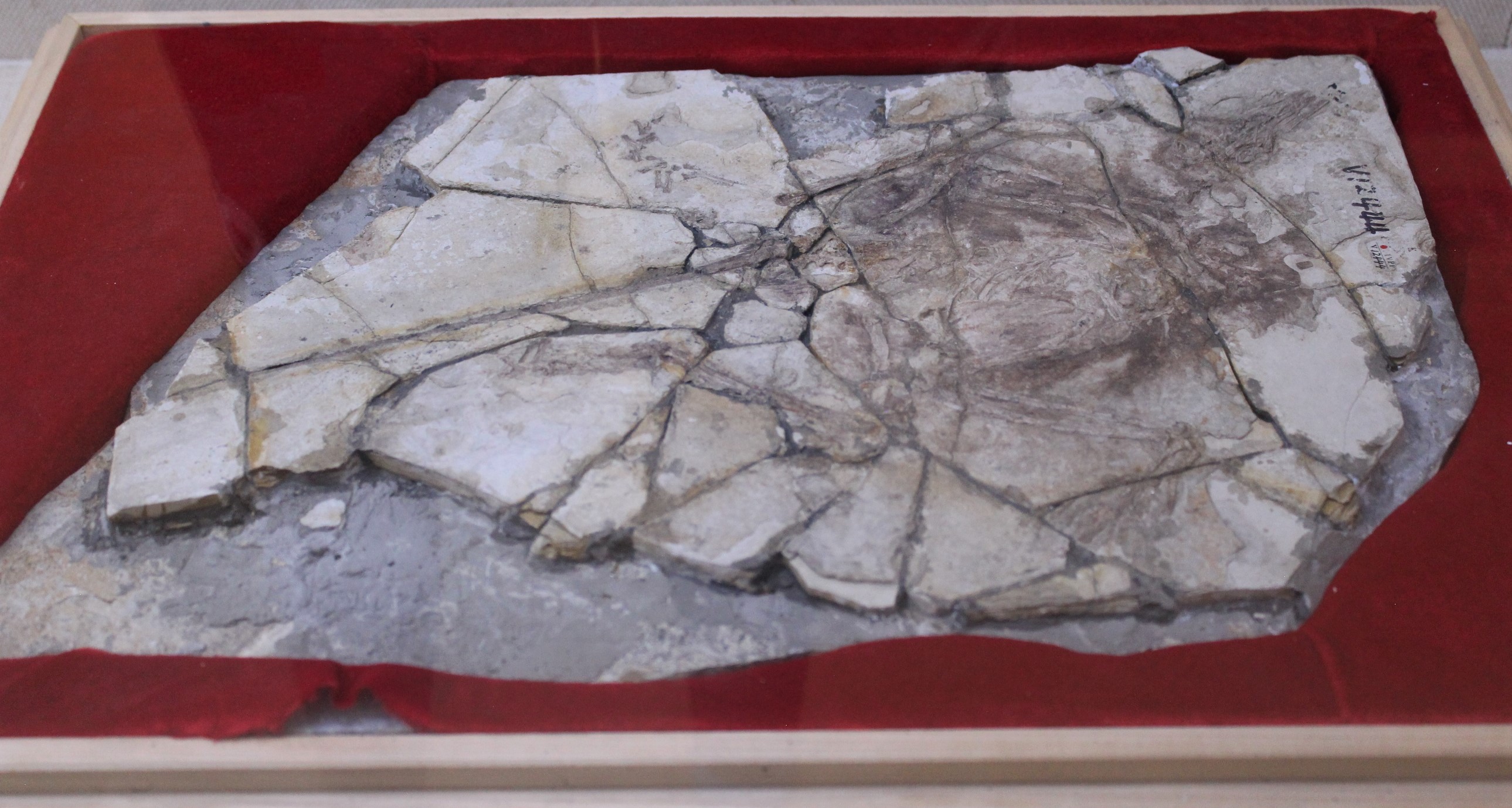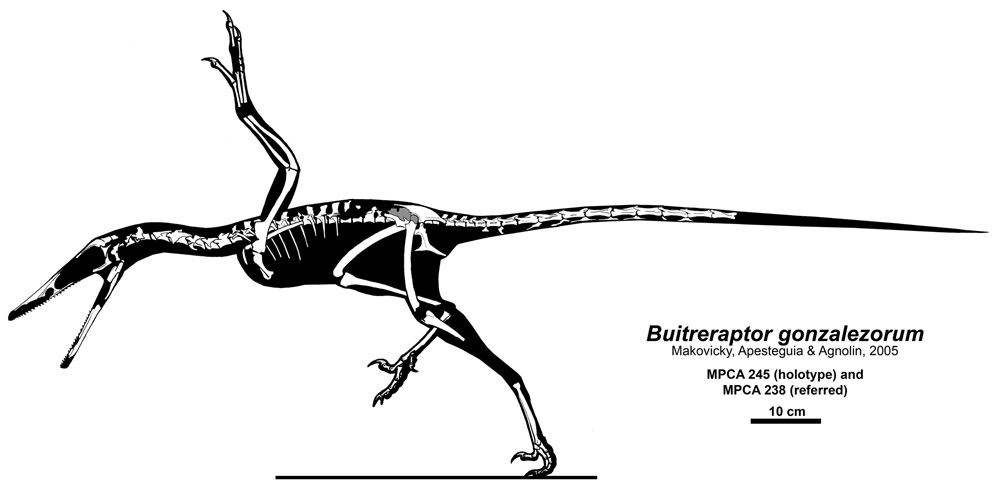|
Dromaeosauridae
Dromaeosauridae () is a family of feathered coelurosaurian theropod dinosaurs. They were generally small to medium-sized feathered carnivores that flourished in the Cretaceous Period. The name Dromaeosauridae means 'running lizards', from Greek ('), meaning 'running at full speed', 'swift', and ('), meaning 'lizard'. In informal usage, they are often called raptors (after '' Velociraptor''), a term popularized by the film ''Jurassic Park''; several genera include the term "raptor" directly in their name, and popular culture has come to emphasize their bird-like appearance and speculated bird-like behavior. Dromaeosaurid fossils have been found across the globe in North America, Europe, Africa, Asia and South America, with some fossils giving credence to the possibility that they inhabited Australia as well. The earliest body fossils are known from the Early Cretaceous (145–140 million years ago), and they survived until the end of the Cretaceous (Maastrichtian stage, 66 ... [...More Info...] [...Related Items...] OR: [Wikipedia] [Google] [Baidu] [Amazon] |
Eudromaeosauria
Eudromaeosauria (International Phonetic Alphabet, ; "true dromaeosaurs") is a subgroup of terrestrial Dromaeosauridae, dromaeosaurid theropod dinosaurs. They were small to large-sized predators that flourished during the Cretaceous Period (geology), Period. Eudromaeosaur fossils are known almost exclusively from the northern hemisphere. They first appeared in the early Cretaceous Period and survived until the end of the Cretaceous (Maastrichtian stage, Ma). The earliest known definitive eudromaeosaur is the probable dromaeosaurine ''Yurgovuchia'', from the Cedar Mountain Formation, dated to 139 million years ago. However, the earlier (143-million-year-old) fossils such as those of ''Nuthetes'' and several indeterminate teeth dating to the Kimmeridgian stage may represent eudromaeosaurs. While other dromaeosaurids filled a variety of specialized ecological niches, mainly those of small predators or specialized piscivores, eudromaeosaurs functioned as hypercarnivores and are sug ... [...More Info...] [...Related Items...] OR: [Wikipedia] [Google] [Baidu] [Amazon] |
Deinonychus
''Deinonychus'' ( ; ) is a genus of Dromaeosauridae, dromaeosaurid Theropoda, theropod dinosaur with one described species, ''Deinonychus antirrhopus''. This species, which could grow up to long, lived during the early Cretaceous Period (geology), Period, about 115–108 million years ago (from the mid-Aptian to early Albian Stage (stratigraphy), stages). Fossils have been recovered from the U.S. states of Montana, Utah, Wyoming, and Oklahoma, in rocks of the Cloverly Formation and Antlers Formation, though teeth that may belong to ''Deinonychus'' have been found much farther east in Maryland. Paleontology, Paleontologist John Ostrom's study of ''Deinonychus'' in the late 1960s revolutionized the way scientists thought about dinosaurs, leading to the "dinosaur renaissance" and igniting the debate on whether dinosaurs were endotherm, warm-blooded or ectotherm, cold-blooded. Before this, the popular conception of dinosaurs had been one of plodding, reptile, reptilian gian ... [...More Info...] [...Related Items...] OR: [Wikipedia] [Google] [Baidu] [Amazon] |
Microraptor
''Microraptor'' (Greek language, Greek, μικρός, ''mīkros'': "small"; Latin language, Latin, ''raptor'': "one who seizes") is a genus of small, four-winged dromaeosaurid dinosaurs. Numerous well-preserved fossil specimens have been recovered from Liaoning, China. They date from the early Cretaceous Jiufotang Formation (Aptian stage), 125 to 120 million years ago. Three species have been named (''M. zhaoianus'', ''M. gui'', and ''M. hanqingi''), though further study has suggested that all of them represent variation in a single species, which is properly called ''M. zhaoianus''. ''Cryptovolans'', initially described as another four-winged dinosaur, is usually considered to be a synonym of ''Microraptor''. Like ''Archaeopteryx'', well-preserved fossils of ''Microraptor'' provide important evidence about the evolutionary relationship between birds and earlier dinosaurs. ''Microraptor'' had long pennaceous feathers that formed aerodynamic surfaces on the arms and tail but a ... [...More Info...] [...Related Items...] OR: [Wikipedia] [Google] [Baidu] [Amazon] |
Pyroraptor
''Pyroraptor'' (meaning "fire thief") is an extinct genus of paravian dinosaur, probably a dromaeosaurid or unenlagiid, from the Late Cretaceous Ibero-Armorican island, of what is now southern France. It lived during the late Campanian and early Maastrichtian stages, approximately 72 million years ago. It is known from a single partial specimen that was found in Provence in 1992, after a forest fire. The animal was named ''Pyroraptor olympius'' by Allain and Taquet in 2000. Discovery and naming Naming and Material The first remains of ''P. olympius'' were discovered in southeastern France, at the La Boucharde locality of the Arc Basin in Provence. It was described and named by French paleontologists Ronan Allain and Philippe Taquet in 2000, the type species and so far the only species is ''Pyroraptor olympius''. The generic name comes from ''πῦρ'' (''pûr'', Greek for "fire") and ''raptor'' (Latin for "thief"), since its remains were discovered after a forest f ... [...More Info...] [...Related Items...] OR: [Wikipedia] [Google] [Baidu] [Amazon] |
Microraptoria
Microraptoria (Greek, μίκρος, ''mīkros'': "small"; Latin, ''raptor'': "one who seizes") is a clade of basal Dromaeosauridae, dromaeosaurid theropod dinosaurs. Definitive microraptorians lived during the Barremian to Aptian stages of the Early Cretaceous in China. Probable microraptorian ichnotaxon ''Dromaeosauriformipes'' was discovered from the Jinju Formation of South Korea, and some fragmentary Late Cretaceous Paraves, paravian fossils in North America have been described as putative members of this clade. Many are known for long feathers on their legs and may have been arboreal, semiarboreal powered fliers, some of which were even capable of launching from the ground.. Most microraptorians were relatively small; adult specimens of ''Microraptor'' range between ) and weigh up to , making them some of the Dinosaur size, smallest known non-avialan dinosaurs.Holtz, Thomas R. Jr. (2011) ''Dinosaurs: The Most Complete, Up-to-Date Encyclopedia for Dinosaur Lovers of All Ages,'Wi ... [...More Info...] [...Related Items...] OR: [Wikipedia] [Google] [Baidu] [Amazon] |
Buitreraptor
''Buitreraptor'' (meaning "La Buitrera seizer") is a genus of dromaeosaurid dinosaurs that lived during the Late Cretaceous of Argentina at the Candeleros Formation. ''Buitreraptor'' was described in 2005 and the type species is ''Buitreraptor gonzalezorum''. It was rooster-sized and had a very elongated head with many small teeth. History of discovery Four specimens of ''Buitreraptor'' were found in 2004 in sandstone in Patagonia, Argentina during an excavation led by Sebastián Apesteguia, researcher of CONICET at the Fundacion Felix de Azara - Maimonides University, and Peter Makovicky, curator of dinosaurs at the Field Museum in Chicago. ''Buitreraptor'' is from the early Late Cretaceous Candeleros Formation, dating to the Cenomanian-Turonian ages approximately 98 to 97 million years ago, when South America was an isolated continent like Australia today. It was uncovered in a famous fossil site named ''La Buitrera'', the "vulture roost". Although dinosaurs are rare in t ... [...More Info...] [...Related Items...] OR: [Wikipedia] [Google] [Baidu] [Amazon] |
Shanag
''Shanag'' is a genus of paravian theropod dinosaur from the Early Cretaceous Period of Mongolia. It may be a dromaeosaurid, but some researchers are skeptical of this classification. The type species is ''S. ashile''. Discovery and naming ''Shanag'' was named and described by Alan Turner, Sunny Hai-Ching Hwang and Mark Norell in 2007. The generic name refers to the black-hatted dancers in the Buddhist Cham dance. The specific name refers to the Ashile Formation, the old name for the layers where ''Shanag'' was found, used by Henry Fairfield Osborn. The holotype of ''Shanag'', IGM 100/1119, was discovered in the Öösh Formation, the stratification of which is uncertain but probably dating to the Berriasian-Barremian. ''Shanag'' bears a strong resemblance to basal Chinese dromaeosaurids such as ''Microraptor'' and '' Sinornithosaurus'', suggesting a close similarity between the fauna of the Öösh deposits, dated tentatively to 130 million years ago, and the Jehol Bi ... [...More Info...] [...Related Items...] OR: [Wikipedia] [Google] [Baidu] [Amazon] |
Velociraptor
''Velociraptor'' (; ) is a genus of small dromaeosaurid dinosaurs that lived in Asia during the Late Cretaceous epoch, about 75 million to 71 million years ago. Two species are currently recognized, although others have been assigned in the past. The type species is ''V. mongoliensis'', named and described in 1924. Fossils of this species have been discovered in the Djadochta Formation, Mongolia. A second species, ''V. osmolskae'', was named in 2008 for skull material from the Bayan Mandahu Formation, China. Smaller than other dromaeosaurids like ''Deinonychus'' and '' Achillobator'', ''Velociraptor'' was about long with a body mass around . It nevertheless shared many of the same anatomical features. It was a bipedal, feathered carnivore with a long tail and an enlarged sickle-shaped claw on each hindfoot, which is thought to have been used to tackle and restrain prey. ''Velociraptor'' can be distinguished from other dromaeosaurids by its long and low skull, with an ... [...More Info...] [...Related Items...] OR: [Wikipedia] [Google] [Baidu] [Amazon] |
Unenlagiidae
Unenlagiidae is a proposed family of eumaniraptoran paravians that includes the subfamilies Unenlagiinae and possibly Halszkaraptorinae. Fossils of both subfamilies have been found in both Gondwanan and Laurasian deposits. The biology of the group suggests that some members were semiaquatic specialists. Classification The family Unenlagiidae traditionally includes the same members as the previously named subfamily of Dromaeosauridae, Unenlagiinae, so Unenlagiidae was often seen as a synonym of Dromaeosauridae. However, since the 2010s, there have been subsequent studies that have questioned this placement, necessitating the revival of the family name. Some have placed unenlagiids as outside Dromaeosauridae, being the sister taxon or closely related to Avialae, while others have placed the newly recognized halszkaraptorines in the family, as basal deinonychosaurs outside Dromaeosauridae and Troodontidae Troodontidae is a clade of bird-like theropod dinosaurs from the La ... [...More Info...] [...Related Items...] OR: [Wikipedia] [Google] [Baidu] [Amazon] |
Hesperonychus
''Hesperonychus'' (meaning "western claw") is a genus of small paravian theropod dinosaur. It may be a dromaeosaurid or an avialan. There is one described species, ''Hesperonychus elizabethae''. The type species was named in honor of Dr. Elizabeth Nicholls of the Royal Tyrrell Museum of Palaeontology who collected it as a student in 1982. It is known from fossils recovered from the Dinosaur Park Formation and possibly from the uppermost strata of the Oldman Formation of Alberta, dating to the Campanian stage of the Late Cretaceous around . Description ''Hesperonychus'' is mainly known from one partial pelvic girdle, holotype specimen UALVP 48778, collected by Dr. Elizabeth Nicholls in Dinosaur Provincial Park in 1982. The fossil remained undescribed, however, until Nick Longrich and Phil Currie published on it in 2009. A number of very small toe bones discovered from the Dinosaur Park Formation and Oldman Formation, including "sickle claws", in the collection of the ... [...More Info...] [...Related Items...] OR: [Wikipedia] [Google] [Baidu] [Amazon] |
Variraptor
''Variraptor'' ( ; "Var thief") is a possibly dubious and potentially chimaeric genus of dromaeosaurid theropod dinosaur from the Late Cretaceous of France. Discovery Between 1992 and 1995 amateur paleontologists Patrick Méchin and Annie Méchin-Salessy uncovered the remains of a small theropod in the Grès à Reptiles Formation (Campanian-Maastrichtian) at La Bastide Neuve, near Fox-Amphoux. The first finds were in 1992 assigned to the theropod genus '' Elopteryx''. A second article, in 1997, concluded they represented a new species. In 1998 this was named by Jean Le Loeuff and Eric Buffetaut as the type species ''Variraptor mechinorum''. The generic name is derived from Latin ''Varus'', referring to the Var River in the Alpes-Maritimes department in the Provence region of southern France, and ''raptor'' meaning "thief". The specific name honours the Méchin couple. The genus is based on three type specimens: a posterior dorsal vertebra (MDE-D168), a sacrum (MDE-D169 ... [...More Info...] [...Related Items...] OR: [Wikipedia] [Google] [Baidu] [Amazon] |
Dromaeosaurus Albertensis
''Dromaeosaurus'' (; ) is a genus of dromaeosaurid theropod dinosaur that lived during the Late Cretaceous period (middle late Campanian and Maastrichtian), sometime between 80 and 69 million years ago, in Alberta, Canada and the western United States. The type species is ''Dromaeosaurus albertensis'', which was described by William Diller Matthew and Barnum Brown in 1922. Its fossils were unearthed in the Hell Creek Formation, Horseshoe Canyon Formation and Dinosaur Park Formation. Teeth attributed to this genus have been found in the Prince Creek Formation. ''Dromaeosaurus'' is the type genus of both Dromaeosauridae and Dromaeosaurinae, which include many genera with similar characteristics to ''Dromaeosaurus'' such as possibly its closest relative ''Dakotaraptor''. ''Dromaeosaurus'' was heavily built, more so than other dromaeosaurs that are similar in size, like ''Velociraptor''. Discovery and naming Despite receiving widespread attention in popular books on dinosaurs, and ... [...More Info...] [...Related Items...] OR: [Wikipedia] [Google] [Baidu] [Amazon] |










